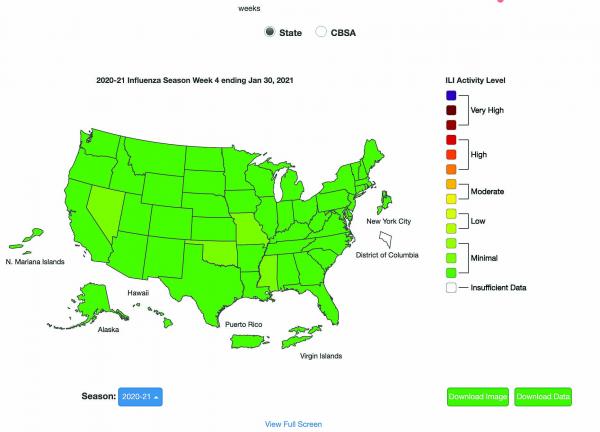February 18, 2021

Dr. Daniel Solomon wasn’t just scared of a bad flu season. With the coronavirus still circulating, he was scared of even a normal flu season.
“I was concerned about overwhelming our hospital capacity,” he said. “Our ICUs have been running on a thin margin, and I was concerned that if there was an additional surge of influenza, we just wouldn’t have the resources to care for patients.”
Solomon is an infectious diseases doctor at Brigham and Women’s Hospital, where he and colleagues review the flu numbers at weekly meetings.
“And we say, ‘Is there any flu activity yet?’ And we always hear, week after week, ‘No.’ So it’s been incredibly mild,” he said. “And there’s this prevailing feeling of amazement and relief that we’re not facing a concurrent epidemic of influenza and Covid.”
In the fall, public health experts in Boston and beyond were dreading the prospect of such a “twindemic.” Now, it’s increasingly clear that, thankfully, this has been the flu season that wasn’t.
Federal flu maps use a traffic-light color scheme — green when flu is low, yellow when it’s medium, and red when it’s high. Here in Massachusetts and around the country, the maps would normally show plenty of yellow and red by February. But this year they’re pure green.
And it’s not just flu that’s low. Dr. Eileen Costello, the chief of ambulatory pediatrics at Boston Medical Center, said it’s other viruses as well.
“We have seen dramatically reduced rates of influenza this year and respiratory synctitial virus, which is a viral infection of infants and very young children that we see,” she said. “It’s the meat and potatoes of every pediatric practice in America, and we’re not seeing it at all this year.
Basically, “flu season hasn’t started,” said Dr. Lynnette Brammer from the Centers for Disease Control and Prevention.
She would know. She’s the country’s lead flu tracker, and she says this is the mildest season since the current tracking system began in 2009.
“I hate to date myself, but this is my 30th flu season in the flu division. I think I can pretty safely say this is certainly the lowest flu season I’ve ever seen,” she said.
Many factors appear to be at work. “Most obviously are the mitigation measures that are in place to try and slow down the COVID pandemic: wearing a mask, washing your hands, keeping a distance,” Brammer said. “Those things are probably having a huge impact on influenza.”
Also, a big drop in travel, especially international travel, and more people getting flu vaccines.
Brammer said much can be learned from this low flu season that could apply in more normal, non-pandemic times. Of course, no one wants pandemic-style restrictions every winter. “But it might be worth considering that in flu season, particularly if it’s a bad one, you might want to consider mask use, particularly for people that are very vulnerable. There’s going to be a lot to think about.”
And many calculations to be made.
“The problem, of course, is that there are tradeoffs,” said Daniel Solomon from Brigham and Women’s. “And the measures we took this year have just had unbelievable costs.”
They range from the toll isolation has taken on many people, including older adults and people who live in long-term care facilities, and learning loss in schools.
Solomon predicts major efforts to analyze which tradeoffs make sense for a more normal year. He’d like to see a nuanced approach to flu season — for example, wearing masks in crowded indoor settings, but not outdoors. He also hopes flu vaccines will be required for schoolchildren, as they were last year in Massachusetts, although the measure generated some controversy.
Normally, the flu kills tens of thousands of Americans every year, including dozens of children. Dr. Jeb Teichman, from the nonprofit Families Fighting Flu, said that last flu season, 188 children died, matching the highest number the CDC has recorded.
This season is very different. “It’s just amazing,” he said. “So far, through week four, that’s through the end of January, one pediatric death.”
He said the record 192 million flu shots given this season were a good match for the flu strains going around. “And my crystal ball, which is really fuzzy, is going to tell me that with the way the SARS-CoV-2 is changing and variants showing up, we’ll be getting a flu shot every year and a Covid booster.”
Flu season lasts through early spring, so experts are saying that although it’s looking like a record-low year, it’s still too early to feel all the way out of the woods.
This article was published by WBUR 90.9FM on Feb. 10. The Reporter and WBUR share content through a media partnership.




